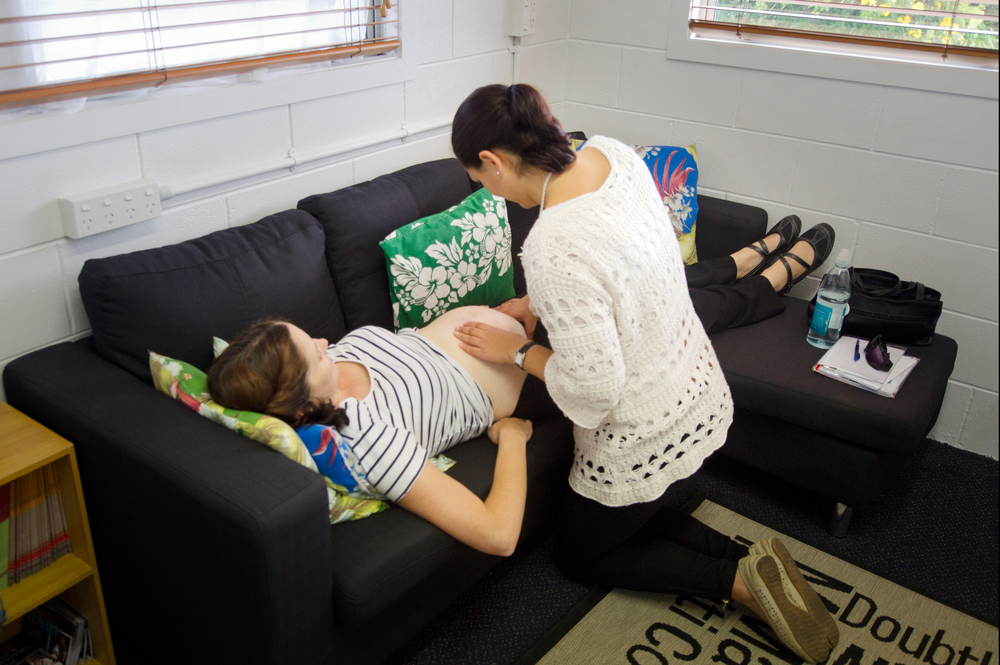What Is a Midwife? | Weighing Pros and Cons

Midwives are trained professionals who help women to give birth and maintain good health before and after pregnancy. This centuries-old profession is expected to become more common in the near future, especially in rural areas, because of a shortage of doctors.
While it's common for women in Europe and other places in the world to deliver their babies with a midwife, American women are more likely to choose an obstetrician. Doctors were responsible for 92 percent of all U.S. births occurring in hospitals in 2012, the most recent year for which data is available from the National Center for Health Statistics. That same year, certified nurse-midwives were involved in nearly 8 percent of deliveries in the hospital setting. By comparison, some estimates suggest that midwives may participate in 50 to 80 percent of births in other Western countries.
But midwifery is enjoying a rebirth in the United States, in part because of an anticipated shortage of obstetricians who can deliver babies. Over the next 10 to 20 years, not only might there be fewer obstetricians overall, but they will also be harder to find in rural areas and low-income communities, said Dr. Hal Lawrence, executive vice president and CEO of the American Congress of Obstetricians and Gynecologists (ACOG).
"Midwives can play a crucial and important role in helping obstetricians provide obstetrical care to women," Lawrence told Live Science. A combination of obstetricians and midwives working together in highly trained obstetrical teams really works well for women, he added.
To prepare for a future of working as collaborative obstetrical teams and expanding access to their services, Lawrence said there is an interest in providing more educational opportunities for obstetricians and midwives to train together early in their medical careers.
An expanded midwifery presence could help meet the needs of a future shortage of maternity care professionals. However, the increasing popularity of midwives also stems from their approach to pregnancy and birth as normal life processes as well as their philosophy of care, which is to intervene medically during labor and delivery only when necessary.
Marginalization
At one point, most American babies made their way into the world with the help of a midwife. But there was a marginalization of midwifery in the United States between 1900 and 1950, and modern obstetrics took over maternity care, said M. Christina Johnson, director of professional practice and health policy for the American College of Nurse-Midwives.
Get the world’s most fascinating discoveries delivered straight to your inbox.
As a result, fewer babies were born at home with the help of a midwife, and doctors began to deliver more babies in hospitals. These days, the vast majority of American midwives work in hospitals where they typically handle low-risk pregnancies.
Johnson, who has been a practicing midwife for more than a decade, said "things are greatly improving for professional midwives in the United States and they have better than ever relationships with their colleagues in obstetrics."
What is a midwife?
The term "midwife" comes from the early English word for "with women." A midwife is a licensed and trained health professional whose best-known skills and expertise involve her role in helping women stay healthy before, during and after pregnancy. This typically includes managing a woman's care during prenatal visits, offering support during labor, delivering the baby and providing postpartum care.
Midwives are experts at using practices that promote the ability to have a normal physiological birth, Johnson said. "It's a holistic philosophy of care."
They tend to encourage a more natural approach to labor pain, including such medication-free practices as massage, relaxation techniques, walking around, showering, rocking in a chair, switching positions or using birthing balls. Certified nurse-midwives can also prescribe labor-inducing drugs, pain medications and offer epidurals if a woman needs or wants them.
But a woman does not have to be pregnant to see a midwife. "Midwives provide independent management of women's health care throughout the lifespan from adolescence through menopause," Johnson said
What do midwives do?
An alternative to choosing an obstetrician or family practitioner during pregnancy, certified nurse-midwives and certified midwives are recognized as primary care providers.They can provide care before, during and after pregnancy as well as offer routine gynecological care to women.
"Midwives are experts in normal pregnancies and are vigilant for things that fall outside of normal," Johnson said. Most pregnancies and births are normal, she added.
During prenatal visits, midwives typically spend more time with their patients than doctors do, answering questions and counseling them about all aspects of a woman's life impacted by pregnancy and childbirth, Johnson said. These discussions might focus on nutrition, exercise, sleep, relationship and emotional issues, parenting skills or breastfeeding.
One common misconception about midwives is that they can only do home births. But that's not the case.
"We're still trying to spread the word that most midwives work in hospital settings" Johnson said. The vast majority of certified nurse-midwives and certified midwives attend births in hospitals, she explained.
Another misconception is that midwives only focus on pregnancy and birth. Many midwives can conduct women's annual gynecological exams and routine check-ups, order lab tests, and prescribe birth control and other medications from the time a woman is a teenager through middle age, Johnson said.
They can also help a woman's male partner to manage a sexually transmitted infection and even provide routine care to a normal newborn, including circumcising baby boys.
Differences between obstetricians and midwives
Obstetricians have completed medical school and also received additional surgical training. Midwives usually have a graduate degree, and they are medically trained and licensed to deliver babies as are obstetricians and some family practitioners.
Obstetricians are best qualified to manage high-risk pregnancies as well as acute problems during labor, ACOG's Lawrence said.
High-risk pregnancies may include multiple births, breech deliveries, and women with a history of uterine surgery (C-sections), pregnancy-related complications (stillbirths or pre-term births), or medical conditions, such as diabetes, high blood pressure, lupus, or inflammatory bowel disease, he explained.
Certified nurse-midwives can deliver women's care for low-risk pregnancies, and if they identify a high-risk patient, they can consult with an obstetrician or refer a woman to one, Lawrence said.
Midwives and obstetricians may work in the same department at some hospitals, or they may be found in the same doctor's office.
Unlike obstetricians, midwives are not allowed to do Cesarean sections, so they may not be the best choice for pregnant women who know they need to deliver their baby this way.
Studies comparing births done by obstetricians and midwives have shown that maternal and fetal health outcomes are equally good, and a midwife's care is as safe as being treated by a physician for low-risk pregnancies.
Different types of midwives
The educational background and training for midwives can vary, as can their medical responsibilities and the locations they are licensed to practice.
Licensed to practice in all 50 states and allowed to prescribe medication, certified nurse- midwives (CNM) have the most extensive credentials, including a nursing degree along with graduate-level training in midwifery.
A second category known as certified midwives (CM) lack nursing backgrounds, but they have a graduate degree in midwifery and are licensed in only five U.S. states.
Currently, there are nearly 12,000 certified nurse-midwives and certified midwives in the United States, Johnson said. They work in a variety of settings, including hospitals, doctors' offices, birth centers, homes or in private practices.
Certified professional midwives (CPM) are another type of women's health professional. They have no college degree requirements, but typically have clinical training under the supervision of a midwife. Most CPMs deliver babies in homes and birth centers.
Health insurers typically cover midwife services within a hospital but may not cover deliveries outside of them.
Pros and cons of choosing a midwife
Pros
- Midwives have a holistic philosophy of care that emphasizes a more natural approach to childbirth and the judicious use of medical interventions, such as continuous fetal monitoring, Johnson said.
- Midwives typically spend more one-on-one time interacting with their patients than a physician can during appointments and prenatal visits, and can provide more hands-on support during labor, birth and postpartum.
- Midwives can provide comprehensive well-woman care from the teenage years through menopause, Johnson said.
- Midwives focus on women's wellness and helping their patients make informed health decisions, on topics ranging from exercise and contraception to fertility and parenting.
Cons
- Midwives of any licensing degree cannot perform a C-section if a pregnant woman needs one (only obstetricians and some family physicians can do the surgery). However, a nurse midwife can be present in the operating room and assist during the procedure if one of her patients requires a Cesarean, Johnson said.
- Midwives typically do not handle high-risk pregnancies.
- Midwives may not be available in every hospital or community setting to meet the needs for their services.
- The public may not be as familiar with the services offered by a midwife compared with those of an obstetrician, family practitioner or a nurse.
- Some health insurance plans may not reimburse for midwife services that occur outside of a hospital setting. A woman should review her policy or check with her health plan to find out what midwifery services are covered, especially if considering a home birth.
Additional resources
- The American College of Nurse-Midwives provides information about midwife practice, philosophy and education.
- The World Health Organization (WHO) offers information about midwifery worldwide.
- The journal Midwifery publishes the latest peer reviewed international research on pregnancy, birth and midwives.
Cari Nierenberg has been writing about health and wellness topics for online news outlets and print publications for more than two decades. Her work has been published by Live Science, The Washington Post, WebMD, Scientific American, among others. She has a Bachelor of Science degree in nutrition from Cornell University and a Master of Science degree in Nutrition and Communication from Boston University.
